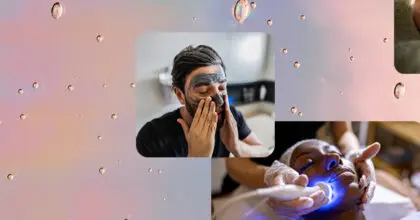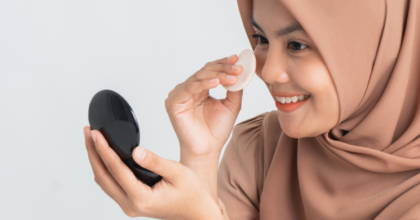Britain’s women spend a beautiful £1.15 billion on facial skincare
While the saying goes that ‘beauty is only skin deep’ it seems that British women are spending more than ever on facial skincare. Indeed, in 2017 British women spent a beautiful £1.15 billion on facial skincare, with sales set to increase by 3% to reach £1.18 billion in 2018. Over the next five years alone, Mintel expects the category to rise by a stunning 15% to reach £1.36 billion in 2023.
Cleaning up the market, an incredible 92% of British women currently use facial cleansers. While face wash (55%) is the UK’s most popular cleansing product, facial cleansing wipes (up from 45% in 2017 to 54% in 2018) and micellar water (up from 19% in 2017 to 27% in 2018) are proving to be star performers. Usage of all facial cleansing products has risen over the past year, even usage of regular/traditional bar soap which has increased from 24% in 2017 to 27% in 2018.
Meanwhile, in terms of facial caring products, day cream and night cream are proving to be the cream of the crop. In the last 12 months, usage of day cream has increased from 59% in 2017 to 66% in 2018; while night creams usage has risen from 39% in 2017 to 48% in 2018.
Roshida Khanom, Associate Director, Beauty & Personal Care at Mintel, said:
“As beauty trends continue to be inspired by Korean facial skincare routines, which can reach as many as 10 steps, British women are adopting multiple cleansing routines and even using different cleansers for different occasions. The rise in different formats, from micellar waters to cleansing milks, oils and lotions, is also driving experimentation. Facial wipes remain popular due to their convenience and are sometimes used instead of a facial cleanser; however, with government plans to eliminate single use products like facial cleansing wipes, the category could be affected.”
SPF confusion
As many Brits fly off for their summer holidays, Mintel research finds just under half (47%) of women use facial skincare products containing SPF, with 39% using a specific sun protection product and 13% using other facial products containing SPF. Despite high usage, there remains confusion around sun protection, as 40% of female facial skincare users find it difficult to know which level of sun protection to use on a daily basis.
When it comes to external factors perceived to impact the appearance of skin, 72% of facial skincare users believe sun exposure has the greatest impact. This is followed by pollution (41%) and cold weather (39%).
And while 2018 has proved to be a scorcher, many women believe the sunshine is playing havoc with their skin as 31% of facial skincare users worry about the impact of the hot weather.
“Whilst sun exposure is considered the biggest external factor impacting the appearance of skin, usage of SPF on the face is relatively low. This suggests that despite knowing about the impact of sun exposure, many women are choosing not to protect themselves. Confusion in the sector could be a reason, presenting an opportunity for brands to do more to help women understand how best to use sun protection on a daily basis. Young women, who are more likely to use different types of sun protection products on their face, may benefit from advice on how to layer their sun protection. Apps that recommend products to add to facial skincare routines on particular days, for example, could help clear up confusion.” Adds Roshida.
Not so smart – mobiles’ impact on skin
When it comes to internal influencers, sleep is considered to have the biggest impact on the appearance of skin for 62% of female facial skincare users, rising to 67% of those aged 55+. Meanwhile, diet (54%) and water consumption (46%) round up the top three internal factors women believe are impacting the appearance of their skin.
And while air conditioning has offered a welcome relief this summer, one in five (21%) facial skincare users believe it is having a negative impact on their skin; meanwhile, 11% believe dust is taking its toll. While many Brits are virtually inseparable from their mobile devices, there is little awareness that electronic devices may be damaging our skin too (5%).
Finally, while Brits are quick to pinpoint a whole host of influencers on the wellbeing of their skin, a quarter (24%) of facial skincare users are resigned to the fact that genetics hold the key to looking good.
“Exposure to heavy blue light/high energy visible light (HEVL) from electronic devices such as computers and smartphones has become a daily occurrence for many consumers. While there is currently little definitive proof that HEVL exposure can impact the appearance of skin, scientific studies as recent as this year suggest such exposure may accelerate pigmentation changes and add fine lines and wrinkles. It is clear from our research that most consumers are unaware of the damage HEVL is capable of doing to our skin. Brands have an opportunity to rewrite the traditional anti-ageing narrative, and advocate a new set of pro-health skin solutions that are driven by blue light protection.” Concludes Roshida.
Press copies of Mintel’s Women’s Facial Skincare UK 2018 report and interviews with Roshida Khanom, Associate Director, Beauty & Personal Care at Mintel, are available on request from the press office.
-
 Discover your next big breakthroughGet smart fast with our exclusive market research reports, delivering the latest data, innovation, trends and strategic recommendations....View Reports
Discover your next big breakthroughGet smart fast with our exclusive market research reports, delivering the latest data, innovation, trends and strategic recommendations....View Reports -
 2026 Global PredictionsOur Predictions go beyond traditional trend analysis. Download to get the predictive intelligence and strategic framework to shape the future of your industry in 2026 and beyond. ...Download now
2026 Global PredictionsOur Predictions go beyond traditional trend analysis. Download to get the predictive intelligence and strategic framework to shape the future of your industry in 2026 and beyond. ...Download now -
Are you after more tailored solutions to help drive Consumer Demand, Market Expansion or Innovation Strategy?Ask for a customised strategic solution from Mintel Consulting today....Find out more































